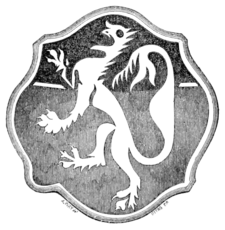tations of the size of the originals. They have been prepared with the utmost care for the forthcoming work on Corinium.
By Mr. Evelyn Philip Shirley.—A small plate, of champ-levé enamel, circa 1350, intended to decorate some piece of metal-work, possibly affixed to a belt, or inlaid in the centre (or "bussellus," the little boss) of the round dish or charger formerly much in use. It was found in January, 1850, in the ground close to the manor-house of Nether Pillerton, Co. Warwick, belonging to the Rev. Henry Mills, in whose possession this curious little relic remains. The accompanying woodcut accurately shows its form and the heraldic charge, being the coat of Hastang, a Warwickshire family of ancient note. The bearing, however, here appears with some difference of colouring. Hastang bore, Azure, a chief gules, over all a lion rampant Or. On this plate the chief is azure, and the field was evidently gules, when freshly enamelled; but a chemical change has taken place,—the cupreous base of the red colouring having been converted into a green incrustation, under which traces of gules may be discerned. This may be an accidental error of the enameller's, or perhaps a difference used by some branch of the family, although not recorded. Dugdale states, that Sir John Hastang, the last of the family, died 39 Edw. III , leaving two daughters, his heirs, who married into the families of Stafford and Salisbury. The parish of Wellesbourne Hastang, where the family held possessions, is not far from Pillerton; they gave also their name to Lemington Hastang, Warwickshire, where may be still seen in a north window a scutcheon of their arms, in brilliant ruby and azure. Mr. Shirley remarked, in regard to ancient heraldic differences in tinctures, that the Roll, t. Edw. II., edited by Sir Harris Nicolas, gives several cases exactly in point. Sir John Strange (p. 6) bore. Gules, two lions passant, argent. Sir Fulk, argent, two lions passant gules.—Sir Fulk Fitzwarin, quarterly, argent, and gules, indented, a mullet sable. Sir William, quarterly, argent and sable, indented. Many other examples might be cited. The Roll cited gives the coats of five of the Hastang family, but none of them have the chief azure.
By Mr. Edward Hoare, Local Secretary at Cork.—A representation of a remarkable bronze fibula, formerly in the Piltown Museum, formed by the late Mr. Anthony.[1] It was found, in 1842, in the Co. Roscommon, and isaccurately pourtrayed by the accompanying woodcut, half the size of the original. This type of fibula appears, as Mr. Hoare remarked, to be almost
- ↑ This valuable collection was sold at Sotheby's in 1848, and a considerable portion, including the precious series of gold ornaments, was purchased by the Trustees of the British Museum.

